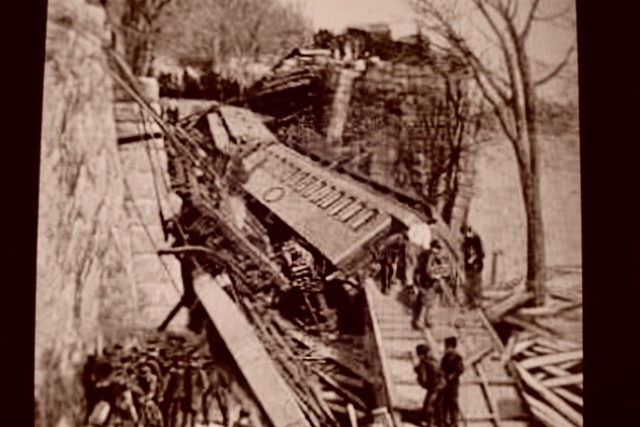Unlike the middle week of most months, which tends to be, pardon the expression, somewhat middling, the middle of March truly delivers. Not only do we get the infamous Ides and the story of Julius Caesar’s colorful downfall (so colorful that Shakespeare expanded it into a play), but also St. Patrick’s day, and here in the JP neighborhood, we also commemorate the local train wreck of ’87, which is by some measures the worst train disaster in MA history. You are no doubt somewhat familiar with the story of the Ides and of the betrayal which led to the leader of Rome getting stabbed to death by his own Senate, evidently during a legislative session. Wm Shakespeare spices it up in his usual theatrical style: we get the soothsayers’ warnings telling Julius to take a day off from work, and the epic line “et tu brute?” that so many tend to comically mispronounce, at least until their more erudite friends correct them. The soothsayer bit has some roots in history, as the Roman historian Suetonius had written that Caesar’s decision to cross the Rubicon five years prior to his death (another legendary act that became an idiom) involved an apparition, making Julius kind of a poster boy for superstition and fateful decisions. The upshot is that sometimes those decisions can be good ones, sometimes not so much, and is supernatural involvement ever a good idea, when it comes down to it?

Watch out in any case, and better you should stick with other decision-making factors. As for St. Patrick’s day, it may or may not be a big deal with you, but you almost certainly are aware of it, especially if you live in any US eastern city with a history of Irish immigration, which seems to be most of them. For some this awareness of St. Patty’s Day can arrive in a mildly traumatic way, when some sadistic kid approaches you in the third grade and gives you a nasty pinch while exclaiming “you’re not wearing green!” or words to that effect, after which you never forget the day, at least until you enter the adult world. That’s when it becomes all about the green beer and cupcakes and such, much more civilized but don’t get sick on too much Irish coffee, it’s not worth it. But the train wreck is the real story here, which only came to my attention from “This Day in History” in the Boston Globe this past Monday, which was a revelation as it happened right here in Jamaica Plain! At the Bussey Bridge! (nitpickers might claim it’s in Roslindale and they’d be right but only by 100 yards or so, and why pick nits?)
In these parts anybody who frequents the Arnold Arboretum (and isn’t that everybody?) quickly becomes familiar with Benjamin Bussey, revolutionary patriot and successful business guy, and Bussey Hill and Bussey Brook and Bussey Street in the Forest Hills section of Boston that Ben once pretty much owned, all of it. But Bussey Bridge? Well yeah, it’s that bridge over South Street in Roslindale that everybody passes under as they take South Street to Rozzie Square, cleverly avoiding busy (and slow) Washington Street, such a smart move.

And they never see the commemorative plaque, affixed high up on the east-facing retaining wall, where it is pretty much invisible to everybody but sharp-eyed dog walkers who care about history. For those who care to bother, the JP Historical Society provides the gripping moment-by-moment narrative of the fateful day, as written by Edward J. Sweeney and published in Yankee magazine (“March 14,1887, dawned gray and cold in Dedham, Massachusetts” etc.). In the end it’s a story of failed infrastructure maintenance and a cautionary tale for present-day America: the old iron bridge failed after the locomotive and first cars crossed the span, and fate dealt its blows to the unlucky in the following cars. What would Julius Caesar have thought? When your number’s up, your number’s up, or so it appears, and worry about this should stop you from taking the train to work? Julius went to work and look what happened! So here we’ve pictures of a reenactment, of sorts, for your education and edification.

It’s fairly self-explanatory, but it should be noted that the locomotive is not the original 4-4-0 American, the typical 19th century train engine, but a 4-6-2 Pacific, the workhorse locomotive of the early 20th century. If you want to view a 4-4-0 in one of the greatest movies of all time, make sure to watch Buster Keaton’s 1926 film, The General. The Pacific in the pictures is my Dad’s old telephone – the ringtone was a trainwhistle! – and it’s the only train paraphernalia we had in the house, except for the engineer’s hat which I think I got from Tom a long time ago, which is way more comfortable and stylish than any baseball cap. I make no apologies for any inaccuracies you might otherwise discover, here. PS don’t preach to me about “pi day” I don’t want to hear it and frankly I think the whole concept is a bit lame but what do I know?




